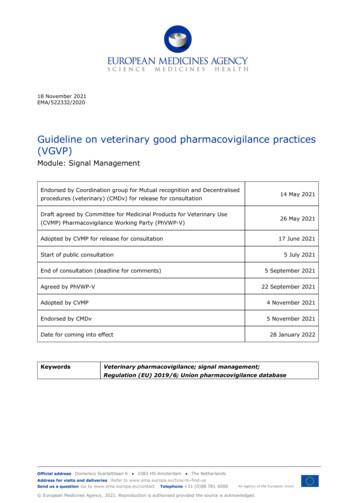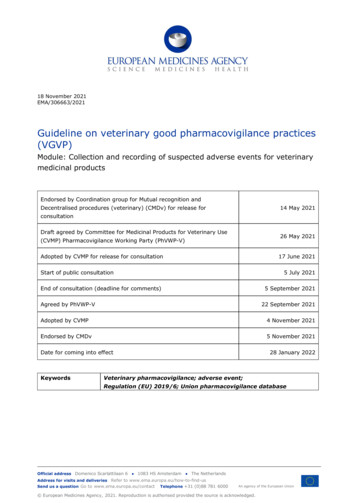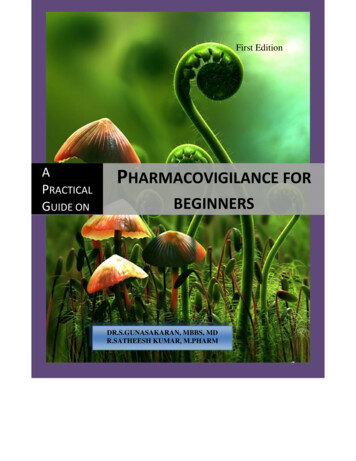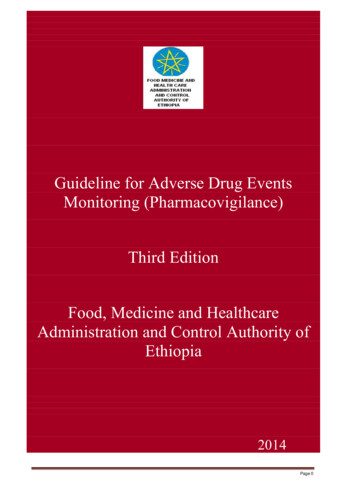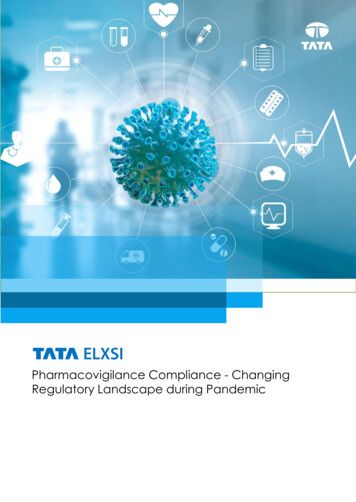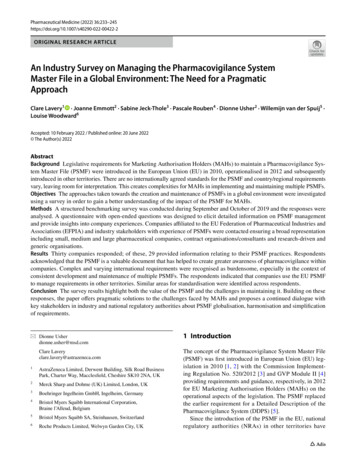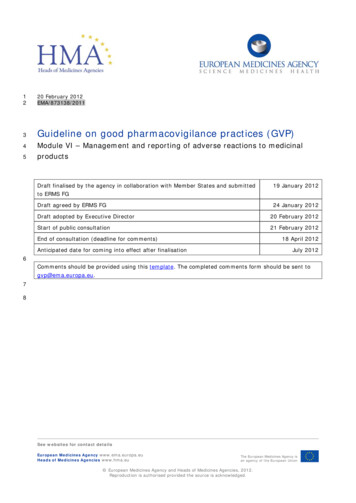
Transcription
1220 February 2012EMA/873138/20113Guideline on good pharmacovigilance practices (GVP)45Module VI – Management and reporting of adverse reactions to medicinalproductsDraft finalised by the agency in collaboration with Member States and submitted19 January 2012to ERMS FGDraft agreed by ERMS FG24 January 2012Draft adopted by Executive Director20 February 2012Start of public consultation21 February 2012End of consultation (deadline for comments)18 April 2012Anticipated date for coming into effect after finalisationJuly 20126Comments should be provided using this template. The completed comments form should be sent togvp@ema.europa.eu.78See websites for contact detailsEuropean Medicines Agency www.ema.europa.euHeads of Medicines Agencies www.hma.euThe European Medicines Agency isan agency of the European Union European Medicines Agency and Heads of Medicines Agencies, 2012.Reproduction is authorised provided the source is acknowledged.
9TABLE OF CONTENTS10VI.A. Introduction . 511VI.A.1. Scope . 512VI.A.2. Definitions . 513VI.A.2.1. Adverse reaction . 514VI.A.2.1.1. Causality . 515VI.A.2.1.2. Overdose, misuse, abuse, medication error, occupational exposure . 616VI.A.2.2. Medicinal product . 617VI.A.2.3. Primary source . 718VI.A.2.4 Seriousness . 719VI.A.2.5. Individual Case Safety Report (ICSR) . 820VI.B. Structures and Processes . 921VI.B.1. Collection of reports . 922VI.B.1.1. Unsolicited reports . 923VI.B.1.1.1. Spontaneous reports . 924VI.B.1.1.2. Literature reports . 925VI.B.1.1.3. Reports from other sources . 1026VI.B.1.1.4. Information on suspected adverse reactions from the internet or digital media . 1027VI.B.1.2. Solicited reports . 1128VI.B.2. Validation of reports . 1129VI.B.3. Follow-up of reports . 1230VI.B.4. Data management . 1331VI.B.5. Quality management . 1432VI.B.6. Special situations . 1433VI.B.6.1. Use of a medicinal product during pregnancy or breastfeeding . 1434VI.B.6.2. Use of a medicinal product in a paediatric or elderly population . 1535VI.B.6.3. Reports of overdose, abuse, misuse, medication error or occupational exposure . 1636VI.B.6.4. Lack of therapeutic efficacy . 1637VI.B.7. Expedited reporting of ICSRs . 1738VI.B.7.1. Expedited reporting time frames . 1739VI.B.8. Reporting modalities . 1740VI.C. Operation of the EU Network . 1941VI.C.1. Interface with safety reporting rules for clinical trials in the EU . 1942VI.C.2. Collection of reports . 2143VI.C.2.1. Member States responsibilities . 2144VI.C.2.2. Marketing authorisation holders responsibilities . 2245VI.C.2.2.1. Spontaneous reports . 2246VI.C.2.2.2. Solicited reports . 2347VI.C.2.2.2.1. Reports from non-interventional studies . 2348VI.C.2.2.2.2. Compassionate use, named patient use . 2449VI.C.2.2.2.3. Patient support programme. 2450VI.C.2.2.3. Reports published in the scientific and medical literature . 245152VI.C.2.2.4. Suspected adverse reactions related to quality defect or falsified medicinalproducts . 25Guideline on good pharmacovigilance practices (GVP) – Module VIEMA/873138/2011Page 2/84
53VI.C.2.2.5. Suspected transmission via a medicinal product of an infectious agent . 2654VI.C.2.2.6. Emerging safety issues . 265556VI.C.2.2.7. Period between the submission of the marketing authorisation application andthe granting of the marketing authorisation . 2757VI.C.2.2.8. Period after suspension, revocation or withdrawal of marketing authorisation . 2758VI.C.2.2.9. Period during a public health emergency . 2859VI.C.2.2.10. Reports from class action lawsuits . 2860VI.C.3. Expedited reporting time frames . 2861VI.C.4. Reporting modalities . 2862VI.C.4.1. Interim arrangements . 2963VI.C.4.2. Final arrangements . 296465VI.C.5. Collaboration with the World Health Organization and the European MonitoringCentre for Drugs and Drug Addiction . 3066VI.C.6. Electronic exchange of safety information in the EU . 306768VI.C.6.1. Applicable guidelines, definitions, international formats, standards andterminologies . 3169VI.C.6.2. Electronic Reporting of Individual Case Safety Reports . 3170VI.C.6.2.1. EudraVigilance Database Modules . 317172VI.C.6.2.1.1. Adverse reaction data collected in the EudraVigilance Post-AuthorisationModule . 3173VI.C.6.2.1.2. Adverse Reaction Data Collected in the EudraVigilance Clinical Trial Module . 3274VI.C.6.2.2. Preparation of Individual Case Safety Reports . 3275VI.C.6.2.2.1. General principles . 3276VI.C.6.2.2.2. Information on suspect, interacting and concomitant medicinal products . 3377VI.C.6.2.2.3. Suspected adverse reactions . 3478VI.C.6.2.2.4. Case narrative and causality assessment . 3579VI.C.6.2.2.5. Test results . 3680VI.C.6.2.2.6. Supplementary information . 3681VI.C.6.2.2.7. Follow-up information. 3682VI.C.6.2.2.8. What to take into account for data privacy laws . 3783VI.C.6.2.2.9. Handling of languages . 3884VI.C.6.2.2.10. Nullification of cases . 3885VI.C.6.2.3. Special situations . 3886VI.C.6.2.3.1. Use of a medicinal product during pregnancy or breastfeeding . 388788VI.C.6.2.3.2. Suspected adverse reaction reports published in the scientific and medicalliterature . 398990VI.C.6.2.3.3. Suspected adverse reactions related to overdose, abuse, misuse, medicationerror or occupational exposure . 3991VI.C.6.2.3.4. Lack of therapeutic efficacy . 409293VI.C.6.2.3.5. Suspected adverse reactions related to quality defect or falsified medicinalproducts . 4094VI.C.6.2.3.6. Suspected transmission via a medicinal product of an infectious agent . 4095VI.C.6.2.3.7. Reports originating in non-interventional organised data collection schemes . 4196VI.C.6.2.3.8. Receipt of missing minimum information . 419798VI.C.6.2.4. Data quality of individual case safety reports transmitted electronically andduplicate management . 4199VI.C.6.2.5. Electronic re-transmission of ICSRs between multiple senders and receivers . 42Guideline on good pharmacovigilance practices (GVP) – Module VIEMA/873138/2011Page 3/84
100VI.C.6.2.6. Electronic reporting through company’s headquarters . 43101VI.C.6.3. Electronic submission of information on medicinal products . 43102VI.Appendix 1. Identification of biological medicinal products . 44103104VI.Appendix 2. Detailed guidance on the monitoring of scientific andmedical literature . 47105VI.Appendix 3. Modalities for expedited reporting . 56106VI.Appendix 3.1. Interim arrangements . 56107VI.Appendix 3.1.1. Interim arrangements applicable to marketing authorisation holders . 61108109VI.Appendix 3.1.2. Interim arrangements applicable to competent authorities in MemberStates . 61110VI.Appendix 3.2. Final arrangements . 62111VI.Appendix 3.2.1. Final arrangements applicable to marketing authorisation holders. 65112113VI.Appendix 3.2.2. Final arrangements applicable to competent authorities in Member States. 65114115VI.Appendix 3.3. Transmission and rerouting of ICSRs to competent authorities in MemberStates . 66116117VI.Appendix 4. Transmission of ICSRs to World Health Organisation (WHO)Collaborating Centre. 70118VI.Appendix 5. Nullification of cases . 74119120VI.Appendix 6. Data quality monitoring of ICSRs transmitted electronically. 78121VI.Appendix 7. Duplicate detection and management of ICSRs . 81122123Guideline on good pharmacovigilance practices (GVP) – Module VIEMA/873138/2011Page 4/84
124VI.A. Introduction125VI.A.1. Scope126This Module addresses the legal requirements detailed in Title IX of Directive 2001/83/EC and Chapter1273 of Regulation (EC) No 726/2004, which are applicable to competent authorities in Member States,128marketing authorisation holders and the Agency as regards the collection, data management and129reporting of suspected adverse reactions associated with medicinal products for human use authorised130in the European Union (EU). Recommendations regarding the reporting of suspected adverse reactions131occurring in special situations are also included in this Module.132All applicable legal requirements are referenced in the way explained in the GVP Introductory Cover133Note and are usually identifiable by the modal verb “shall”. Guidance for the implementation of legal134requirements is provided using the modal verb “should”.135VI.A.2. Definitions136The definitions provided in Article 1 of Directive 2001/83/EC shall be applied for the purpose of this137Module; of particular relevance are those provided in this Chapter. Some general principles presented138in the ICH-E2A and ICH-E2D guidelines 1 and in the Commission Implementing Regulation on the139Performance of Pharmacovigilance Activities Provided for in Regulation (EC) No 726/2004 and Directive1402001/83/EC should also be adhered to; they are included as well in this Chapter.141VI.A.2.1. Adverse reaction142An adverse reaction is a response to a medicinal product which is noxious and unintended [DIR Art 1].143This includes adverse reactions which arise from:144 use of a medicinal product within the terms of the marketing authorisation;145 use outside the terms of the marketing authorisation, including overdose, misuse, abuse and146medication errors;147 occupational exposure.148VI.A.2.1.1. Causality149In accordance with the ICH-E2A guideline, the definition of an adverse reaction implies at least a150reasonable possibility of a causal relationship between a suspected medicinal product and an adverse151event.152A reaction, in contrast to an event, is characterised by the fact that a causal relationship between a153medicinal product and an occurrence is suspected.154For regulatory reporting purposes, as detailed in the ICH-E2D guideline, if an event is spontaneously155reported, even if the relationship is unknown or unstated, it meets the definition of an adverse156reaction. Therefore all spontaneous reports submitted by healthcare professionals, patients or157consumers are considered suspected adverse reactions, since they convey the suspicions of the158primary sources, unless the reporters specifically state they believe the events to be ine on good pharmacovigilance practices (GVP) – Module VIEMA/873138/2011Page 5/84
160VI.A.2.1.2. Overdose, misuse, abuse, medication error, occupational exposure161a. Overdose162This refers to the administration of a quantity of a medicinal product given per administration or per163day, which is above the maximal recommended dose according to the authorised product information.164This shall also take into account cumulative effects due to overdose.165b. Misuse166This refers to situations where the medicinal product is intentionally and inappropriately used not in167accordance with the prescribed or authorised dose, route of administration, and/or the indication(s) or168within the legal status of its supply (e.g. without prescription for medicinal products subjects to169medical prescription).170c. Abuse171As defined in Article 1 of Directive 2001/83/EC, this relates to the sporadic or persistent, intentional172excessive use of a medicinal product, which is accompanied by harmful physical or psychological173effects.174d. Medication error175This refers to any unintentional error in the prescribing, dispensing or administration of a medicinal176product while in the control of the healthcare professional, patient or consumer.177e. Occupational exposure178This corresponds to the exposure to a medicinal product for human use as a result of one’s occupation.179VI.A.2.2. Medicinal product180A medicinal product is characterised by any substance or combination of substances,181 presented as having properties for treating or preventing disease in human beings; or182 which may be used in or administered to human beings either with a view to restoring, correcting183or modifying physiological functions by exerting a pharmacological, immunological or metabolic184action, or to making a medical diagnosis [DIR Art 1].185In accordance with Article 107 of Directive 2011/83/EC, the scope of this module is not only applicable186to medicinal products authorised in the EU but also to any such medicinal products commercialised187outside the EU by the same marketing authorisation holder (see VI.C.2.2). This is valid independently188of the strengths, pharmaceutical forms, routes of administration, presentations, approved indications189or trade names of the medicinal product. Since a medicinal product is authorised with a defined190composition, all the adverse reactions suspected to be related to any of the active substances being191part of a medicinal product authorised in the EU should be managed in accordance with the192requirements presented in this module.193The guidance provided in this Module also applies mutatis mutandis to medicinal products supplied in194the context of compassionate use (see VI.C.2.2.2.2) as defined in Article 83 of Regulation (EC) No195726/2004. As the case may be, this guidance may also apply to named patient use as defined under196Article 5(1) of Directive 2001/83/EC.Guideline on good pharmacovigilance practices (GVP) – Module VIEMA/873138/2011Page 6/84
197VI.A.2.3. Primary source198The primary source of the information on a suspected adverse reaction(s) is the person who provides199information about the case. Several primary sources, such as healthcare professionals and/or a patient200or consumer, may provide information on the same case. In this situation, all the primary sources’201details should be included in the case report, with the “Primary source(s)” section repeated as202necessary in line with the ICH-E2B(R2) guideline 2.203In accordance with the ICH-E2D guideline,204 205206a healthcare professional is defined as a medically-qualified person such as a physician, dentist,pharmacist, nurse, coroner or as otherwise specified by local regulations; 207a consumer is defined as a person who is not a healthcare professional such as a patient, lawyer,friend or relative of a patient.208Medical documentations (e.g. laboratory or other test data) that support the occurrence of the209suspected adverse reaction, or which indicate that an identifiable healthcare professional suspects a210causal relationship between a medicinal product and the reported adverse reaction, are sufficient to211consider the spontaneous report as confirmed by a healthcare professional.212If a patient or consumer initially reports more than one reaction and at least one receives medical213confirmation, the whole report should be documented as a spontaneous report confirmed by a214healthcare professional and be reported accordingly. Similarly, if a report is submitted by a medically215qualified patient, friend or relative of the patient, the case should also be considered as a healthcare216professional report.217VI.A.2.4 Seriousness218As described in the ICH-E2A guideline, a serious adverse reaction corresponds to any untoward219medical occurrence that at any dose results in death, is life-threatening, requires inpatient220hospitalisation or prolongation of existing hospitalisation, results in persistent or significant disability or221incapacity, is a congenital anomaly/birth defect.222The characteristics/consequences should be considered at the time of the reaction to determine the223seriousness of a case. For example, life-threatening refers to a reaction in which the patient was at risk224of death at the time of the reaction; it does not refer to a reaction that hypothetically might have225caused death if more severe.226Medical and scientific judgement should be exercised in deciding whether other situations should be227considered as serious reactions. Some medical events may jeopardise the subject or may require an228intervention to prevent one of the above characteristics/consequences. Such important medical events229should be considered as serious 3. The EudraVigilance Expert Working Group has co-ordinated the230development of an important medical event (IME) terms list based on the Medical Dictionary for231Regulatory Activities (MedDRA). This IME list aims to facilitate the classification of suspected adverse232reactions, the analysis of aggregated data and the assessment of the cases in the framework of the233day-to-day pharmacovigilance activities. The IME list is intended for guidance purposes only and is234available on the EudraVigilance web site 4. It is regularly updated in line with the latest version of235MedDRA.234See VI.C.6 as regards the electronic reporting of ICSRs in the EU.Examples are provided in Section II.B of ICH E2A an/textforIME.asp).Guideline on good pharmacovigilance practices (GVP) – Module VIEMA/873138/2011Page 7/84
236VI.A.2.5. Individual Case Safety Report (ICSR)237As described in [IM Annex I.1], this refers to the format and content for the reporting of one or several238suspected adverse reactions in relation to a medicinal product that occur in a single patient at a239specific point of time. A valid ICSR for expedited reporting shall include at least an identifiable reporter,240an identifiable patient, at least one suspect adverse reaction and a suspect medicinal product.241Guideline on good pharmacovigilance practices (GVP) – Module VIEMA/873138/2011Page 8/84
242VI.B. Structures and Processes243Section B of this Module highlights the general principles in relation to the collection, recording and244reporting of suspected adverse reactions associated with a medicinal product for human use, which are245applicable to competent authorities and marketing authorisation holders. The definitions and246recommendations provided in VI.A should be followed. EU requirements are presented in VI.C.247VI.B.1. Collection of reports248Competent authorities and marketing authorisation holders should take appropriate measures in order249to collect and collate all reports of suspected adverse reactions associated with medicinal products for250human use originating from unsolicited or solicited sources.251For this purpose, a pharmacovigilance system should be developed to allow the acquisition of sufficient252information for the scientific evaluation of those reports.253The system should be designed so that it helps to ensure that the collected reports are authentic,254legible, accurate, consistent, verifiable and as complete as possible for their clinical assessment.255All notifications that contain pharmacovigilance data should be recorded and archived in compliance256with the applicable data protection requirements (see VI.C.6.2.2.8 for EU recommendations).257The system should also be structured in a way that allows for reports of suspected adverse reactions to258be validated in a timely manner and exchanged between competent authorities and marketing259authorisation holders within the legal expedited time frame (see VI.B.7.1).260In accordance with the ICH-E2D guideline, two types of safety reports are distinguished in the post-261authorisation phase; reports originating from unsolicited sources and those reported as solicited.262VI.B.1.1. Unsolicited reports263VI.B.1.1.1. Spontaneous reports264A spontaneous report is an unsolicited communication by a healthcare professional, patient or265consumer to a competent authority, marketing authorisation holder or other organisation (e.g.266Regional Centre, Poison Control Centre) that describes one or more suspected adverse reactions in a267patient who was given one or more medicinal products and that does not derive from a study or any268organised data collection schemes as defined in VI.B.1.2.269Stimulated reporting that occur consequent to a “Direct Healthcare Professional Communication”,270publication in the press, questioning of healthcare professionals by company representatives, or class271action lawsuits should be considered spontaneous reports.272Patient or consumer adverse reactions reports should be handled as spontaneous reports irrespective273of any subsequent “medical confirmation”.274The expedited reporting time frames and reporting modalities for spontaneous reports are described in275VI.B.7 and VI.B.8.276VI.B.1.1.2. Literature reports277The scientific and medical literature is a significant source of information for the monitoring of the278safety profile and of the risk-benefit balance of medicinal products, particularly in relation to the279detection of new safety signals or emerging safety issues. Marketing authorisation holders areGuideline on good pharmacovigilance practices (GVP) – Module VIEMA/873138/2011Page 9/84
280therefore expected to maintain awareness of possible publications through a systematic literature281review of widely used reference databases (e.g. Medline, Excerpta Medica or Embase) no less282frequently than once a week. The marketing authorisation holder should ensure that the literature283review includes the use of reference databases that contain the largest reference of articles in relation284to the medicinal product properties 5. In addition, all company offices are encouraged to be aware of285publications in their local journals and to bring them to the attention of the company safety286department as appropriate.287Reports of suspected adverse reactions from the scientific and medical literature, including relevant288published abstracts from meetings and draft manuscripts, should be reviewed by marketing289authorisation holders to identify and record ICSRs related to medicinal products issued from290spontaneous reports or non-interventional post-authorisation studies.291If multiple medicinal products are mentioned in the publication, only those which are identified by the292publication's author(s) as having at least a possible causal association with the suspected adverse293reaction should be considered by the concerned marketing authorisation holder(s). This also applies to294reports identified in the scientific and medical literature that originate in a country where a company295holds a marketing authorisation but has never commercialised the medicinal product.296Valid ICSRs shall be reported according to the modalities detailed in VI.B.7 and VI.B.8. The regulatory297reporting clock starts as soon as the marketing authorisation holder has knowledge that the case298meets the minimum criteria for expedited reporting (see VI.B.2). One case should be created for each299reported identifiable patient and relevant medical information should be provided. The publication300reference(s) should be given as the report source.301EU specific requirements, as regards the medicinal products and scientific publications which are not302monitored by the Agency and for which valid ISCRs shall be reported by marketing authorisation303holders, are provided in VI.C.2.2.3.304VI.B.1.1.3. Reports from other sources305If a marketing authorisation holder becomes aware of a report of a suspected adverse reaction from a306non-medical source, for example the lay press or other media, it should be handled as a spontaneous307report. Every attempt should be made to follow-up the case to obtain the minimum information that308constitutes a valid ICSR. The same expedited reporting time frames should be applied as for other309spontaneous reports.310VI.B.1.1.4. Information on suspected adverse reactions from the internet or digital media311Marketing authorisation holders should regularly screen internet or digital media 6 under their312management or responsibility, for potential reports of suspected adverse reactions. In this aspect,313digital media is considered to be company sponsored if it is owned, paid for or controlled by the314marketing authorisation holder 7. The frequency of the screening should allow for potential valid ICSRs315to be reported to the competent authorities within the appropriate expedited timeframe base
Guideline on good pharmacovigilance practices (GVP) - Module VI EMA/873138/2011 Page 5/84 124 VI.A. Introduction 125 VI.A.1. Scope 126 This Module addresses the legal requirements detailed in Title IX of Directive 2001/83/EC and Chapter

